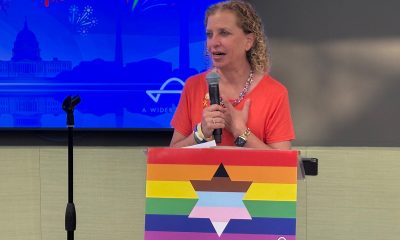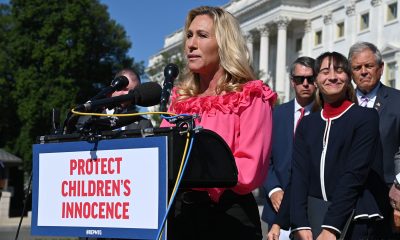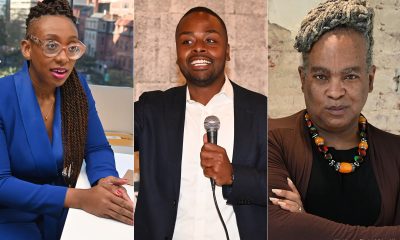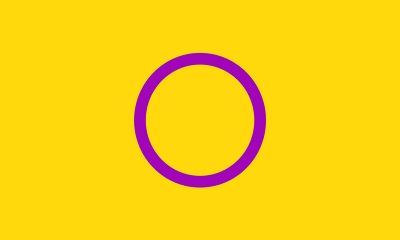Opinions
Pinkwashing & Israeli occupation – not so complicated
LGBT delegation missed chance to meet gay Palestinians


The author, Pauline Park, at the gap in the separation wall at Al-Wallaja east of the Israeli frontier. (Photo courtesy Park)
BY Pauline Park
“The concept of ‘pinkwashing’ emerged as a hot topic throughout the week,” Kevin Naff wrote of his participation as part of “a delegation of nine LGBT leaders from the United States” to Israel in November (“Israel as ‘gay heaven’? It’s complicated,” Times of Israel, Nov. 10). The delegation tour was sponsored by Project Interchange, a program of the American Jewish Committee, which is aggressive in its defense of the Israeli occupation of Palestine.
Naff quotes a speaker who addressed the group, Gal Uchovsky, as telling the delegates “that we had arrived in ‘gay heaven’” and that Israel is “the best LGBT country in the world” whose “LGBT residents face no serious problems that he could identify.” My Israeli friends would certainly contest Uchovsky’s absurd claim that LGBT Israelis “face no serious problems.” Fortuntely, Naff was able to recognize Uchovsky’s propaganda for what it was.
One would get a very different impression speaking primarily or exclusively with wealthy gay Jewish Israeli men in North Tel Aviv — as Naff and his fellow delegates seem to have done — than if one spoke with LGBT Israelis from more marginalized communities, including lesbians and bisexuals, who often feel marginalized by gay men in Tel Aviv and elsewhere in Israel; transgendered women, who face police harassment and brutality in Tel Aviv and other cities in Israel just as they do in New York and other U.S. cities; Israelis who face discrimination because of their of Mizrahi (Sephardic) Jewish ethnic origins; or refugees from Africa and elsewhere who may be LGBT (though not necessarily openly so) but who have no right to remain in Israel, because the state of Israel does not recognize non-Jewish economic refugees or those fleeing political persecution — regardless of their sexual orientation or gender identity.
And that’s not even to mention the pervasive discrimination that Palestinians with Israeli citizenship face. As Prof. David Lloyd argued persuasively in a December 2013 analysis for the Electronic Intifada, the crucial distinction between “citizenship” (ezrahut) and “nationality” (le’um) in Israeli law privileges Jewish Israelis over Palestinians living in Israel because “citizenship” is in effect a second-class citizenship without nationality status.
“Some critics claim the country’s embrace of LGBT rights is merely a propaganda effort to claim the mantle of modernity and establish a stark contrast to homophobic regimes in the West Bank, Gaza and elsewhere in the Middle East,” Naff writes. In doing so, Naff is in fact rearticulating the very discourse in which Uchovsky was engaging in when describing Israel as a gay paradise — the attempt to use Israel’s record on gay rights (supposedly better than that of its Arab and Muslim neighbors) as a justification for an Israeli occupation that is illegal under international law, or at the very least as a means to distract attention from it.
Naff’s delegation appears to have met with only one Palestinian — “a scholar and Fatah and PLO adviser,” Abu Zayyad. But meeting with a single official with the Palestinian Authority — widely viewed by many West Bank Palestinians as little more than a tool of the Israeli occupation — hardly constitutes balance when the rest of the tour was devoted to meeting with LGBT Israelis and Israeli officials.
“The focus of the visit — LGBT issues — was often overshadowed by the frustrating stalemate of the Palestinian-Israeli conflict. Why can’t the two sides come to an agreement on a two-state solution? It’s complicated,” Naff writes. And yet, is the issue of the Israeli occupation of Palestine really that complicated? For all of the complications and complexities of the situation, it is at root quite simple: the indigenous people who have lived in Palestine for centuries are being systematically dispossessed of their land and their rights by a foreign military occupation that is illegal under international law and that even the United States does not recognize as legitimate. And that occupation makes no exception for Palestinians who might be LGBT/queer, who face the same restrictions and daily humiliations living under Israeli occupation as non-LGBT Palestinians. And contrary to propaganda in circulation, Israel is not and cannot be a haven or a refuge for LGBT Palestinians because there is no such thing as refugee status for non-Jews in Israel, regardless of sexual orientation or gender identity.
Rather than hearing pinkwashing propaganda from the likes of Gal Uchovsky, Naff and his colleagues would have learned far more if they had met with Palestinian villagers and farmers under siege from Israeli settlers and the Israeli military in the West Bank, as I have. I participated in the first U.S. LGBTQ delegation tour of Palestine in January 2012 and met with many Palestinians — both LGBT and non-LGBT — throughout the West Bank, from Nablus in the north to Hebron in the south and Ramallah in between. Staying two nights with a Palestinian family in Dheishe in Bethelem, one of the largest refugee camps in the West Bank, I had the opportunity to speak at length with Palestinians about conditions in the occupied territories.
Naff expresses his disappointment with the decision of alQaws and Aswat to decline the invitation to meet with his delegation. AlQaws and Aswat, two of the leading Palestinian LGBT groups, are doing vital work on behalf of queer Palestinians under extremely difficult circumstances that no U.S.-based LGBT organization has to face. The 16 members of my delegation met with members of both alQaws and Aswat for extensive discussions about the impact of the occupation on LGBT Palestinians, and those discussions were productive and enlightening. It seems to me that Naff’s group of relatively privileged LGBT Americans should have recognized how problematic it was to demand that LGBT/queer Palestinians either facing pervasive discrimination within Israel or living under a crushing foreign military occupation in the West Bank engage them in dialogue, which is the privilege of the powerful. True dialogue is simply not possible when one party is holding a gun to the other’s head, which is what “dialogue” with a people living under a brutal and illegal military occupation represents.
I might add that members of Naff’s delegation could have found opportunities to engage with LGBT/queer Palestinians even before leaving the U.S. and could do so now that they are back from their tour; they can also feel free to engage members of New York City Queers Against Israeli Apartheid if they wish to hear our views on Palestinians and the Israeli occupation.
The conclusion I have come to is that pinkwashing does nothing for queer Palestinians and arguably makes things worse by generating more support for Israel and the occupation in the U.S., Europe and elsewhere. The liberation of queer Palestinians is inseparable from that of Palestinian society as a whole; whatever privileges wealthy gay Jewish Israeli men may enjoy in the affluent districts of North Tel Aviv do nothing for queer Palestinians being crushed by a brutal and illegal foreign military occupation that is daily dispossessing more and more Palestinians of their lands and their homes.
Given the intransigence of the government of Binyamin Netanyahu — the most right-wing prime minister in Israeli history — and his determination to move forward with the ethnic cleansing of East Jerusalem and the de facto annexation of the West Bank, it seems to me that only boycott, divestment and sanctions (BDS) against apartheid Israel will advance the cause of the peaceful resolution of the impasse that the Israeli government itself has created with its endless occupation of Palestine and construction of an apartheid regime.
Pauline Park is a member of New York City Queers Against Israeli Apartheid, founded in 2011. She was a member of the first U.S. LGBTQ delegation to Palestine in January 2012.
(Kevin Naff responds: After members of our LGBT delegation expressed concerns that we were not given access to more of the Palestinian perspective, Project Interchange arranged a follow-up conference call in November with Dr. Khalil Shikaki, director of the Palestinian Center for Policy & Survey Research. I shared Pauline Park’s concerns over pinkwashing, but Project Interchange worked hard to present a balanced itinerary, which included visits to the West Bank, Ramallah and the edge of the Gaza Strip. I welcome Park’s invitation to learn more about NYCQAIA and will follow up with her.)
Opinions
Trump’s ‘American people derangement syndrome’
Voters must stop him before he destroys democracy

Trump, in a deranged, evil, post on X, accused Rob Reiner of suffering from “Trump derangement syndrome.” I guess that would apply to everyone who thinks Trump is an evil, dangerous, asshole who is trying to destroy our society as we know it. With that definition, I would surmise the felon himself suffers from “American people derangement syndrome,” because clearly, he thinks we are all evil, dumb, assholes, and a danger to him, and the fascists surrounding him.
His speech to the nation was called bellicose, by the New York Times. I would call it unhinged and vile. It was a plea to the populace, containing a pack of lies, to continue to believe his lies, and distortions. We all know the felon is full of shit when telling us prices have come down. We go shopping every week to feed ourselves and our families, even if he doesn’t. We have to pay heating and rent bills each month. We know since he became president nearly a year ago, all those costs have gone up. Talk to any honest person at a chamber of commerce in your area, and they will tell you small businesses are suffering. They will tell you the felon’s tariffs are hurting everyone. We know he is screwing the poor and middle class; trying to end SNAP benefits, and refusing to help with healthcare costs. All the while giving tax breaks to corporations, and the rich. People are not dumb Mr. Felon, and your lies are no longer resonating.
The evil, deranged, felon in the White House lives in a world where he can do favors for his friends in return for getting them to donate hundreds of millions for his follies. He is a grifter who hosts dinners for rich people to make money for his crypto business. He is said to have made more than $3 billon since his election. This while farmers are going broke, and losing their farms, because his tariffs screwed them. He is undermining vaccines and caused a measles epidemic in the United States. This a disease eradicated before he came into office. He ended grants to research cures for HIV/AIDS, Parkinson’s, Alzheimer’s, cancer, and an assortment of childhood diseases. He stopped research grants for mRNA vaccines. When we have the next pandemic, and it will come, that will result in millions of deaths, all on his head.
He is embarrassing the United States around the world. They watch him give unhinged speeches, raise and lower tariffs irrationally, screw our allies, and now trying to interfere in their elections. He is bombing fishing boats, claiming they are carrying drugs, with no proof at all. Then he releases from prison the man who brought more cocaine into the country than anyone else ever did. All this is what the lying, cheating, grifting, evil, heartless, felon in the White House, is doing to you, the good people of the United States, and the world. He sounds more unhinged every day while trying to blame everything on former President Biden and Democrats, who haven’t controlled the levers of government in nearly a year.
I know the results of the 2025 elections must scare him. They show him the majority no longer accept his BS. We will go into 2026, and the midterm elections, with our eyes wide open. He wants to be King and we don’t want kings in our country. He has what his chief of staff calls, “an alcoholic’s personality” “because he believes there’s nothing he can’t do.” She is right about that, but we will call him on it in the next election. We will say clearly, with our voices, and our votes, “no more, enough is enough.” We are taking back the country and will throw out anyone in office who still supports him.
We try and forgive those who voted for him, as long as they now recognize he lied to them, and is screwing them. Young people must understand they will suffer their whole lives because he is a climate denier. Latino and Hispanic voters, who believed he was going to support them, now see he wants to deport them. Farmers who once thought he supported them, until he screwed them. We must now all join together, and show the evil SOB in the White House, who is building his grand ballroom, taking planes, and other gifts, and pardoning the guilty; his time is coming to an end. Again, we will go into the voting booth, eyes wide open, and vote to stop him before he completely destroys our lives, our families, our democracy, and brings fascism to our country.
Peter Rosenstein is a longtime LGBTQ rights and Democratic Party activist.
Opinions
Using movement to boost your mental health during holidays
Sometimes the goal is simply steadiness
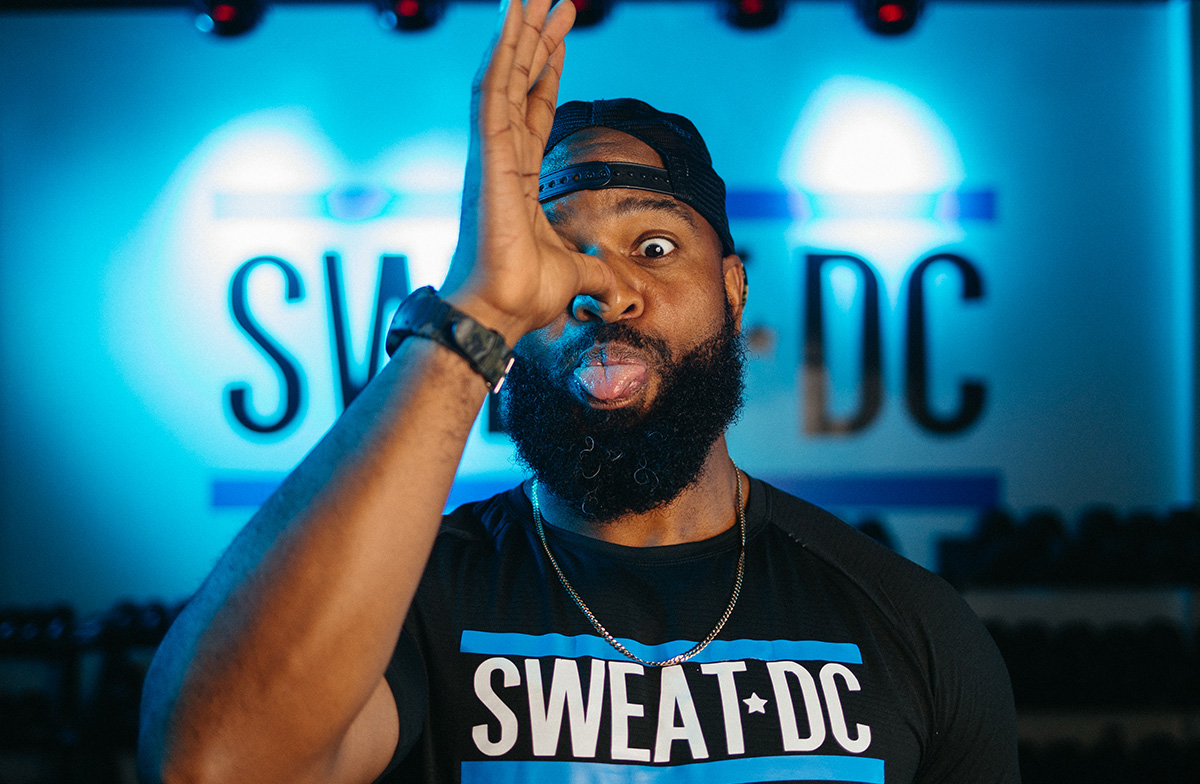
We’re told this is the season of Ho Ho Ho. Joy. Family. Home.
But let’s be honest. The holidays are stressful for almost everyone. Even in the best situations, this time of year comes with pressure. Expectations. Family dynamics. Financial stress. Comparison. The emotional labor of trying to make everything feel warm and magical while quietly holding a lot inside.
For some people, home is comfort. For others, it’s complicated. A place where old roles come back fast. Where you’re expected to be a version of yourself that no longer fits. Where love exists, but understanding feels incomplete.
And for many of us in the LGBTQ community, that stress can carry extra weight. Sitting at tables where parts of who you are feel debated instead of celebrated. Navigating politics and beliefs that don’t feel abstract, but personal. Deciding when to speak up, when to stay quiet, and when to just go refill your drink. Grief changes how the holidays land.
For me, the holidays have often been quiet. I’m deeply grateful for the family I still have and the support they’ve given me, and I also need to be real. I’ve been jealous. Jealous AF. Jealous that I can’t go home and hug my mother. Jealous that my dad isn’t there. Jealous when I see the cozy movie version of the holidays play out in other people’s lives. Not because they don’t deserve it, but because I wish I had it too.
Long before fitness became my career, the gym was my sanctuary. Without movement, these seasons would have been much harder. My body changed as a byproduct, sure, but what movement gave me first was something more important. Stability. A place to put grief. A way to move stress out of my body when words weren’t enough. Stress doesn’t just live in the mind.
We like to think stress is something we can talk through or think our way out of. But stress and anxiety live in the body. Chronic stress has been shown to disrupt sleep, weaken the immune system, and show up physically as tension, fatigue, and pain. When it’s left unaddressed, it doesn’t just affect how we feel emotionally. It affects how we function.
Most people don’t come into fitness because they’re thriving. After 20 years of coaching, almost everyone I’ve met started with physical goals. Lose weight. Build muscle. Look different. What they don’t always see is how stress, burnout, emotional eating, and putting everyone else first got them there. Most people aren’t failing. They’re exhausted.
When we talk about mental health, we think about therapy, medication, boundaries, vacations, or staying away from that one family member who always finds a way to press your buttons. All of those things matter. They save lives. But movement is rarely treated as part of the mental health plan, even though every single person who moves consistently feels better mentally. Not perfect. Just better. As my business partner Chase likes to say, sexy is the side effect. This isn’t just empathy. It’s a strategy.
The holidays don’t sneak up on us. We know which dinners will be hard. We know which brunches will test our patience. We know which days we’ll feel alone. So instead of raw-dogging our way through it, we can prep for it.
First, plan your movement the same way you plan the hard stuff. If you know a dinner is going to be stressful, don’t show up already hot. Schedule your workout that day, the day before, or in the days leading up so your nervous system is already in a better place. You’re not trying to win the day. You’re trying to lower the starting line.
Second, give yourself time limits. You don’t have to do the full four hours. There’s a lot of space between not showing up at all and staying until you’re emotionally fried. Do an hour. Schedule a fake work meeting if you have to. Show up in a way that lets you stay in character and protect your peace. That still counts.
Third, move how you can move. If you’re traveling, alone, out of routine, or your gym is closed, it doesn’t have to be perfect. Twenty minutes works. A walk works. A jog works. A short breathing or meditation session works. Even a quick bodyweight circuit in your childhood bedroom works. And if you need ideas, we share our monthly programming and workouts on the SWEAT DC Instagram so anyone can follow along and move, wherever they are.
Fitness doesn’t have to look good to be effective. It just has to be intentional. Especially this time of year.
As the year comes to a close, my hope isn’t that this season suddenly feels easy. It’s that you feel supported. That you remember movement isn’t about punishment or perfection. It’s about care.
Sometimes the goal isn’t happiness. Sometimes the goal is steadiness. And honestly, some years, that’s a win. We can do that. And we don’t have to do it alone.
Gerard Burley, also known as Coach G, is founder and CEO of Sweat DC.
Commentary
Protecting the trans community is not optional for elected allies and candidates
One of oldest political tactics is blaming vulnerable group for societal woes

Being an ally to the trans community is not a conditional position for me, nor should it be for any candidate. My allyship doesn’t hinge on polling, focus groups, or whether courage feels politically convenient. At a time when trans people, especially trans youth of color, are under coordinated attack, elected officials and candidates must do more than offer quiet support. We must take a public and solid stand.
History shows us how these moments begin. One of the oldest political tactics is to single out the most vulnerable and blame them for society’s anxieties — not because they are responsible, but because they are easier to blame than those with power and protection. In Nazi Germany, Jewish people were primarily targeted, but they were not the only demographic who suffered elimination. LGBTQ people, disabled people, Romani communities, political dissidents, and others were also rounded up, imprisoned, and killed. Among the earliest acts of fascistic repression was the destruction of Berlin’s Institute for Sexual Science, a pioneering center for gender-affirming care and LGBTQ research. These books and medical records were among the first to be confiscated and burned. It is not a coincidence that these same communities are now the first to suffer under this regime, they are our canaries in the coal mine signaling what’s to come.
Congress, emboldened by the rhetoric of the Donald Trump campaign, recently passed HR 3492 to criminalize healthcare workers who provide gender-affirming healthcare with fines and imprisonment. This bill, sponsored by celebrity politicians like Marjorie Taylor Greene, puts politics and headlines over people and health outcomes. Healthcare that a number of cis-gendered people also benefit from byway of hair regeneration and surgery, male and female breast augmentation, hormone replacement therapy etc. Even when these bills targeting this care do not pass, they do real damage. They create fear among patients, legal uncertainty for providers, and instability for clinics that serve the most marginalized people in our communities.
Here in D.C., organizations like Planned Parenthood and Whitman-Walker Health are lifelines for many communities. They provide gender-affirming care alongside primary care, mental health services, HIV treatment, and preventative medicine. When healthcare is politicized or criminalized, people don’t wait for court rulings — they delay care, ration medication, or disappear from the system entirely.
As a pharmacist, I know exactly what that means. These are life-saving medications. Continuity of care matters. Criminalizing and politicizing healthcare does not protect children or families — it puts lives at risk.
Instead of centering these realities, political discourse has been deliberately diverted toward a manufactured panic about trans women in sports. Let me be clear: trans women deserve to be protected and allowed to compete just like anyone else. Athletics have always included people with different bodies, strengths, and abilities. Girls and women will always encounter competitors who are stronger or faster — that is not a gender or sports crisis, it is the nature of competition.
Sports are meant to teach fairness, mutual respect, and the shared spirit of competition — not suspicion or exclusion. We should not police young people’s bodies, and we should reject attempts to single out trans youth as a political distraction. Families and doctors should be the authority on sex and gender identity.
This narrative has been cynically amplified by the right, but too often Democrats have allowed it to take hold rather than forcefully rejecting it. It is imperative to pay attention to what is happening — and to push back against every attempt to dehumanize anyone for political gain.
Trans people have always been part of our communities and our democracy. Protecting the most vulnerable is not radical — it is the foundation of a just society. My work is grounded in that commitment, and I will not waver from it. I’m proud to have hired trans political team Down Ballot to lead my campaign for DC Council At Large. We need more ally leaders of all stages to stand up for the LGBTQ+ community. We must let elected detractors know that when they come for them, then they come for all of us. We cannot allow Fox News and social media trolls to create a narrative that scares us away from protecting marginalized populations. We must stand up and do what’s right.
Anything less is not leadership.
Rep. Oye Owolewa is running for an at-large seat on the D.C. Council.

